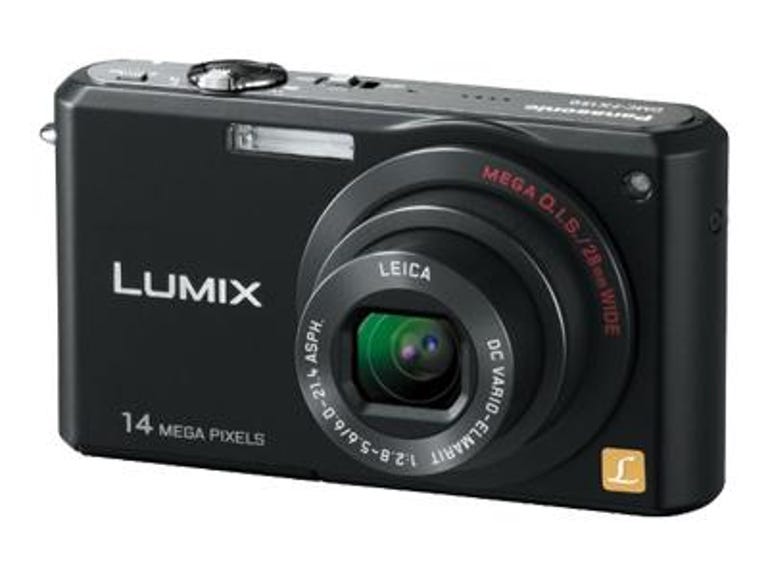 Why You Can Trust CNET
Why You Can Trust CNET Panasonic Lumix DMC-FX150 review: Panasonic Lumix DMC-FX150
Panasonic Lumix DMC-FX150
Instead of being the camera you take with you while your digital SLR stays home, the 14-megapixel Panasonic Lumix DMC-FX150 is the one you go for when you simply want a little more control over exposure than the typical compact offers. It doesn't have full manual controls and it's not the speediest, but its mix of shooting options, ease of use, and photo quality makes it worth its high-end price tag.
The Good
The Bad
The Bottom Line
The camera (available in silver or black) is 3.8 inches wide by 2.1 inches high by 1 inch thick and weighs 6.2 ounces with battery and SD/SDHC card--definitely small enough for a pants pocket, though just sliding under our thickness criterion for an ultracompact. On top sits a power switch, shutter release surrounded by a zoom ring, and a button for Panasonic's Extra Optical Zoom feature. A single press of the E.Zoom button fully extends the wide-angle 3.6x f2.8-5.6 28-100mm lens. Press it again and it increases the optical zoom power to 7.7x, but drops the resolution to 3 megapixels. A third press brings the lens all the way back. The quick-zoom aspect of this button is nice, but the "extra optical zoom" is digital trickery.
To the right of the 2.7-inch LCD are the remaining controls. The mode dial is set into the body at the top right, directly above the textured thumb rest where your thumb naturally falls. To its right is a switch for changing between shooting to playback. Below that is a traditional five-button navigation panel followed by Display and context-sensitive Quick Menu buttons. The control layout, while maybe not as fast as newer scroll-wheel navigation designs, will be very familiar to anyone that's ever picked up a digital camera.
Other cameras in its class load up on modes, but the FX150 provides only a handful, making things refreshingly simple. There's Panasonic's auto-everything mode--Intelligent Auto (iA)--and the requisite Scene mode (with 22 scenes to pick from) handling point-and-shoot duties, while Program AE and Manual Exposure modes offer more control for those looking for it. Rounding things out is a Movie mode capable of capturing video up to a HD resolution of 720p in QuickTime motion JPEG format. (The camera has three output options, too: mini-AV, mini-component, and USB 2.0.)
If you're considering the FX150 based on the availability of manual controls, be warned that it's a simplified manual system. For starters, there's no manual focus. Next, though you can adjust shutter speed in small increments, aperture is limited to two steps: f2.8 and f9.0 in wide and f5.6 and f18 in telephoto. Finally, exposure compensation doesn't function in this mode. However, the inclusion of these limited settings does allow you some creative freedom that lower-end ultracompacts don't. Also, there are plenty of other ways to experiment with the FX150 thanks to an extensive list of shooting options.
Basic settings include being able to tweak contrast, sharpness, saturation, and the amount of noise reduction; shooting in black and white, sepia, or with cool or warm temperatures; and setting the sensitivity up to ISO 1,600 (this can also be locked so it never shoots above a particular ISO). But then you get things like normal exposure bracketing as well as color bracketing that will take shots in standard and black and white, standard and sepia, or standard, black and white, and sepia. And mixed in with the scene modes are things like Multi-Exposure mode that superimposes up to three consecutively shot images together and lets you view them onscreen as you shoot so you can compose the final result, and Starry Sky that reduces shutter speed to 15, 30, or 60 seconds. You also get the option to capture JPEG, raw, or raw plus a low-resolution JPEG photos.
While I'm still on the fence on the value of a 14-megapixel resolution in a camera this small, the FX150 at least takes decent photos--especially at ISO 100. Photos are sharp in the center, though on the sides there's the distortion typical of a point-and-shoot lens, which results in softness there as well as a tendency to exhibit purple fringing. They display good detail, color, white balance, and exposure. There's also enough resolution to make cropping possible without a significant loss of quality. Global softness kicks in at ISO 200, but detail remains good through ISO 400. At ISO 800 detail and color are degraded because of the amount of noise, but should still be usable at small sizes and onscreen.
None of the 14-megapixel cameras we've tested has been a particularly fast performer, and the FX150 falls in the middle of its class. With a slide of the power switch, the FX150 is ready to shoot in 1.9 seconds. Focusing and shooting in good light takes 0.8 second and 1 second in less optimal conditions, both on the high side relative to its peers. Its shot-to-shot time is 2.4 seconds in JPEG and 2.5 seconds in raw. Turning on the flash adds 0.6 second to the time. The camera averaged 1.2 frames per second in CNET Labs' tests. It didn't feel quite as slow as the numbers suggest while I shot with it, however.
As mentioned earlier, the FX150 does have a 720p HD movie capture mode. The results look really good in comparison with other HD-capable compacts we've tested. However, its optical zoom is crippled while recording.
While the Panasonic Lumix DMC-FX150 doesn't offer much for shooters seeking manual controls, it isn't overly complicated to operate and provides a very satisfying point-and-shoot experience with plenty of features for experimentation.
(Shorter bars indicate better performance)
(Longer bars indicate better performance)


